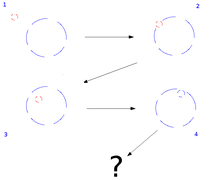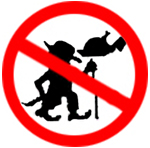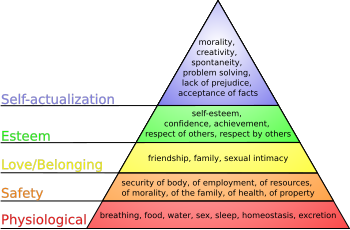Managing vandalism
 From Wikiversity - Reading time: 4 min
From Wikiversity - Reading time: 4 min
| Educational level: this is a non-formal education resource. |
| Completion status: this resource is ~50% complete. |
This is a course in how to manage vandalism in wikis. Assume Good Faith and Etiquette are important when dealing with vandalism.
One scenario
[edit | edit source]So, what might be one scenario (please note that there are other pathways/scenarios possible) with a "vandal"?

- red circle: a person/group acting weird (regarding - some - people's opinion)
- blue circle: let's say carelessly this is Wikiversity (though it consists of many individuals - note: we don't say pages) and the line is not drawn through to show that we cannot "shutdown gates" - our doors are open all the time.
- 1: both exist (somehow)
- 2: first contact (e.g. reading pages)
- 3. "inside" WV (and doing something)
- 4: contributing to Wikiversity's mission (the mission of Wikiversity from that moment)
So, what can happen after situation 3 ? This is completely in our hands. In most projects very likely the vandal is being "fought" and is "brought" back to a previous state (and the game can continue again from that state). The more effort-taking way is to help the circle understand and realize what Wikiversity is about and ultimately making the circle contribute also to Wikiversity's mission.
Something to think:
- Who will take the effort to help a circle reach step >3 ? Why act at all like this?
- Will this succeed with every "red circle"?
- What happens when you exchange the meaning of the red and blue circle?
- Why not read Vandal Wiki?
Prevention
[edit | edit source]A way to manage vandalism is to assume good faith and not create vandals. Newcomers often try a few tests as they try to get familar with the Wiki interface, format, syntax, etc. Please do not bite the newcomers (anything can be reverted in a wiki) - if you kindly tell them to stop or use the Wikiversity:Sandbox they usually will if they are doing it in good faith.
Traits of a good vandal manager
[edit | edit source]
The following are some traits that are helpful to have if you are managing vandalism:
- The knowledge that anything in wikis can be reverted. It takes some time to reach this kind of belief. But when reached, you see many things at Wikiversity with another pair of eyes.
- A trait a vandal manager should have is to be calm. People who are calm are less apt to be uncivil to others. If you get mad at them do not let them know. If you are rude to them you are "feeding the troll."
- A good vandal manager can work fast and not make too many mistakes. It is a natural thing to make mistakes so if a vandal manager makes a mistake once in a while that is fine.
Motivations (for vandalism)
[edit | edit source]
Please note that some of these are also motivational factors for "normal" Wikiversity participants.
- Boredom alleviation
- To get attention
- To advertise (wiki spam)
- For a sense of humour
- For the risk/thrill/'gameplay'
- For a sense of power or revenge
- To learn and 'show off' MediaWiki skills
- Frustration with inadequate content
- Disagreement with POV or dislike of specific topics
- To annoy or upset a particular user or group
Types of vandalism
[edit | edit source]
Actually you can list here many things they just depend on the person's creativity:
- Add text or pictures that may offend people (e.g., racist comments)
- Add nonsense (e.g., "kpa9jfs098jasd")
- Adding fiction/false information (e.g., "George Washington was an elephant that became a president")
- Remove information from pages
- Move pages to other names (e.g., names that make no sense or that are offensive)
- Spam (e.g. "visit my website to buy _____ cheap!"
Tools
[edit | edit source]
- Recent changes: Checking the recent changes is a good way to manage vandalism. Most edits listed there are not vandalism of course. So to make your chances greater at finding (and perhaps reverting) vandalism you might focus on new editors and IPs. Focus on articles relating to sex, religion, politics, recent events, and articles about unpopular people. These are usually good locations to find "suspicious" changes.
- Watch pages: In MediaWiki, if you add a page to your watchlist, entries of that page in Recent changes will appear in bold to help you notice changes to pages you are watching.
- IRC: IRC recent changes channels are a good tool to use. They allow you to see edits when they happen and also let you see the edit summary the person left which can help you in telling vandalism apart from good edits.
- Rollback: Rollback allows you to revert vandalism with just a click of a button.
- Huggle is a wiki-browser which makes reverting vandalism a one-click experience. Unfortunately, it only works on Wikipedia. To use it, you must have Rollback, and you must also be approved for Huggle.
- Twinkle a wiki-browser that makes welcoming, reverting, and warning an easy-to-go experience.
 KSF
KSF